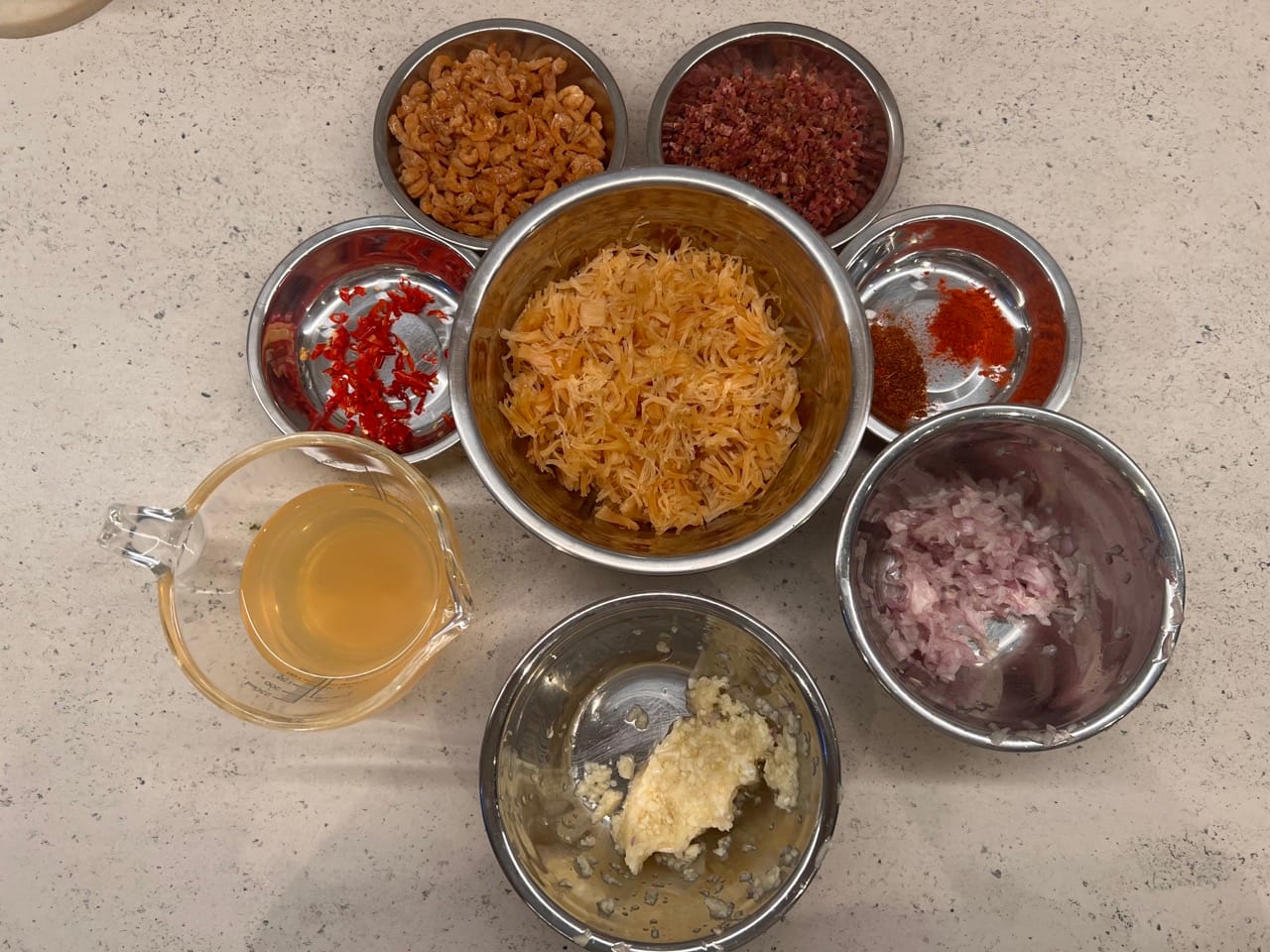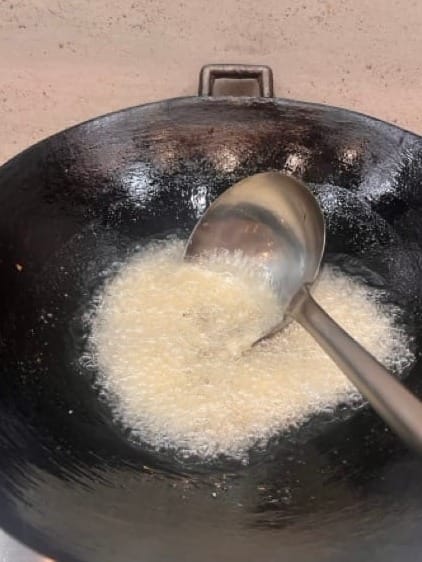XO sauce musings
I feel that most XO sauce you run into is crap. Despite it being on so many restaurant menus, for sale in supermarkets and restaurants in little bottles, and featured in so many recipe blogs and YouTube videos, most of the stuff out there isn't very good at all.

The web is awash with recipes for XO sauce, the Rolls Royce of umami-rich chilli sauces invented in Hong Kong in the 80s. XO is now commonly used in not just Chinese restaurants but at all sorts of other cuisines due to its unique flavour profile.
I feel that most XO sauce you run into is crap. Despite it being on so many restaurant menus, for sale in supermarkets and restaurants in little bottles, and featured in so many recipe blogs and YouTube videos, most of the stuff out there isn't very good at all when compared to the best, even on seemingly authoritative English-language web sites that top Google searches like Serious Eats or Woks of Life. The top flaws are not paying attention to the quality of the ingredients, frying everything together at the same time, and not simmering the sauce.
I been lucky enough to taste the condiment in some of the finest starred Hong Kong Cantonese restaurants in the world and learned from such a chef how to make the sauce. I've been trying to replicate the taste at home for a number of years, each time improving the technique and flavour. I thought I'd share here a few lessons learned over the years, in particular how to make better XO than the expensive but poor-quality stuff solid in supermarkets and standard restaurants.
Mistakes in XO sauce and recipes
Here I look at many areas where I've seen XO sauce go wrong, as well as things needed to make it top notch.
Mistake: One-shot frying
Many recipes produce a sub-standard product because all the ingredients are fried together, adding one after the other, at the same temperature, without removing the prior ingredients first. This is pretty much impossible to get right; some things will end up over-cooked or crispy while others end up undercooked. Some recipes start with garlic (it will over-cook) and some end with shallots (they take longer to cook and need a lower temperature). The Michelin chefs I've seen making XO sauce will always fry ingredients individually before combining, sometimes at different temperatures, to guarantee each one is perfectly cooked such that maximum flavour is extracted, but no more than that. Then the ingredients are re-combined and simmered in a sauce, which brings us to...
Mistake: Simmering sauce
Some recipes omit simmering completely. XO sauce isn't just deep fried, it's also simmered, until most of the liquid is absorbed and the oil covers the remaining ingredients. The simmering takes longer than just frying but adds far more layers of flavour to the condiment. See below for a recipe, but the question is, what sauce is used for simmering? For a basic version, use some soaking juices plus oyster sauce and rock sugar. For a luxurious, top notch version, my chef friend will substitute the oyster sauce with the multi-day cooking juices left over from poaching dried abalone which includes reduced essence of abalone, pork ribs, chicken feet, dried scallops etc.
Must: Ingredients
Firstly, the sauce only tastes right if you use the right ingredients, and that means high-quality ones. XO sauce is designed to be "extra old" and, quite frankly, made using expensive ingredients. If you want to skip on the quality of ingredients, just go and buy a jar from your local restaurant or supermarket; if you want the best, fly to South China or Japan or make it yourself by using top quality dried seafood, dried shrimps and ham that mass producers avoid for cost reasons.
Good quality dried scallops are the most important thing: Small, fingernail-sized rubbery ones, or overly soft or moist ones, don't taste as good as larger, firmer ones. The best quality are considered to be from Japan (e.g. Hokkaido). You want to find some that aren't as hard as rock, but also not obviously oily or sticky, with no black spots or cracks. The colour should be a natural gold or amber, with a slight sheen, not a pale yellow (e.g. north-east China) or soft (e.g. Vietnam). Smell should be a mild, sweet seafood aroma. Generally, you get what you pay for.
Similarly, supermarket dried prawns are inferior to Sakura shrimp from Taiwan or Japan, or high quality Chaozhou dried shrimps; bags of random chilli powder is inferior to the colour and fragrance of freshly ground and toasted Erjingtiao; and Virginia ham or young Jinhua ham can't compare with the strong aftertaste of premium grade aged Jinhua.
Lastly, the oil. Soybean oil doesn't taste good, olive oil won't match, etc. I use a high-quality artisan peanut oil from Guangzhou. I find peanut oil matches the flavour profile well.
All of these ingredients can be sourced in Hong Kong, but in Europe and the USA some of them are difficult to find. Generally, however, dried seafood can be imported, and with taste testing, one can substitute a fine Jinhua ham with a fine Iberico ham and achieve a similarly wonderful, but slightly different tasting, sauce.
Must: Texture and consistency
Pre-made jars of XO sauce will often end up with a minced mash-bill of ingredients, that come out nicely on a spoon but where the individual parts can't be distinguished. In a good XO sauce, each ingredient should still be visually distinguishable, but in the mouth the taste and texture should layer beautifully together bound together by the fragrant oil, but still with a bit of chew such that the XO sauce is "eaten, not licked." The consistency of the condiment mustn't be watery and may be adjusted during simmering if needed. XO sauce must be thicker than fresh peanut oil – thick enough to cling to your food when dipped, but also not so thick that it won't mix well into a stir fry. Under no circumstances can it be solid, hard or crispy (one early attempt of mine turned into XO chilli crisp, which was great, but not what I intended!).
Must: Balance
The primary ingredient class in XO sauce is dried seafood, typically scallops and shrimps but sometimes small fish or fish meat. Under no circumstances should the sauce taste fishy, you want the type of sweetness that's extracted from the dried seafood. That said, different people have different preferences for what they like to see in XO: Personally, I prefer dried scallops to be the dominant ingredient, paired with proportionally less shallots, garlic, chillies and ham. Others prefer a meatier taste.
Recipe: My go-to XO sauce
This is the delicious XO sauce I keep in the fridge for guests to nibble and dip, to add to crabmeat and egg white fried rice, to stir fry with ho fun noodles, to pan fry with chang fen rice rolls or radish cake, to use in salads, or for whatever else comes to mind.
Ingredients
Ingredients as follows, with proportions very approximate since they should be adjusted according to your taste preference. As mentioned earlier, I prefer dried scallops as the dominant flavour.

- Centre: Around 8 large dried scallops, soaked overnight, then shredded. If still not easy to separate after soaking, steam them briefly.
- 1 o'clock: Minced Jinhua ham, cut into 2mm by 2mm pieces.
- 3 o'clock: A teaspoon of freshly ground dried erjingtiao chilli, and a teaspoon of Kashmiri chilli powder.
- 4 o'clock: Two minced Thai (small) shallots.
- 6 o'clock: Plenty of minced garlic.
- 8 o'clock: Soaking juices from the dried scallops.
- 9 o'clock: 2 minced fresh Thai chillies.
- 11 o'clock: Briefly soaked and washed dried shrimp.
The cooking steps are as follows
Frying

- Add a good ladle full of high quality oil to the wok.
- Fry the chopped garlic over a medium-low heat, stop before it's about to turn golden, and take out with a fine mesh strainer and put in a bowl. You must take out all of the bits.
- Similarly, fry the dried shallots over a medium-low heat. They will take much longer than the garlic, but stop before they turn golden. Take them all out and put them in a bowl.
- Fry the dried scallops over a low heat. Stop them before they turn transparent and go crispy; too dry, and you end up with too much chew in the sauce.
- Fry the dried shrimps. They will go really, really fast. You just want to give them a quick dunk and then take them out.
Simmering

Turn off the heat to let the oil cool to below boiling point. Stir in the chilli powders. Add the fried ingredients, the fresh chilli, the soaking juices and either a good couple of table spoons of oyster sauce plus a bit of chicken broth, or some cooking sauces from making dried abalone. Turn on the heat, and bring the sauce to a simmer, and keep simmering until sufficiently thickened. Keep the temperature at a gentle, low and slow simmer: You don't want the oil to get to frying temperature, the goal is to evaporate off the newly added liquids and reduce until the texture is as you prefer. When no longer watery, add a pinch of rock sugar for sweetness, and adjust the seasoning.
Bottling
Put the hot sauce straight into a dry, hot (using boiling water, steaming or oven) glass jar, tighten the lid and leave it to cool. Put it in the fridge. So long as you use a clean spoon each time you take sauce out of it, and a layer of oil sits on top, it can keep for weeks or even months.
Variant: Kumquat XO sauce
I've tried variants of XO sauce with tiny dried fish added late in the cooking, peanuts, or all manner of other things. There's no set recipe here, so you have some freedom to invent. Here's one I made earlier.
Dried and fresh citrus pair very well with umami-rich or spicy dishes – think preserved mandarin peels and black beans in Cantonese steamed dishes, kumquat chilli sauces from Taiwan or Hainan, or salty lime and chilli pairings in Mexican cooking, so one day while staring at a tree overloaded with kumquats I thought why not try to make a more spicy XO sauce with citrus flavours? I did, and it's been a hit with everyone that's tried it. To make, modify the above recipe as follows:
- Take 20 freshly picked kumquats and wash them, and cut them in half.
- Squeeze out the juice half at a time through a fine-mesh sieve, remove and discard the flesh and pips, but keep the skin. You'll be left with a bowl of kumquat juice and a pile of kumquat skins.
- Add the kumquat juice to the dried scallop soaking water in the previous recipe.
- Shred the kumquat skins finely, to about 2mm shreds.
- Finely wash and shred the outside three habanero chilli peppers, discarding the pips and core, and use instead of the fresh Thai chillies.
- Omit the Kashmiri chilli powder.
Unfortunately, I didn't take a photo of this fabulous creation 😦
